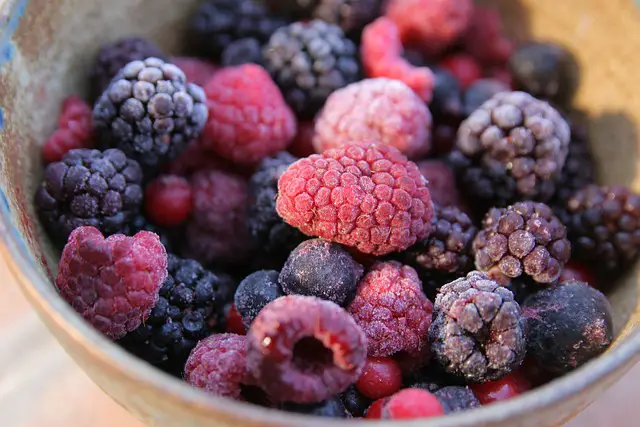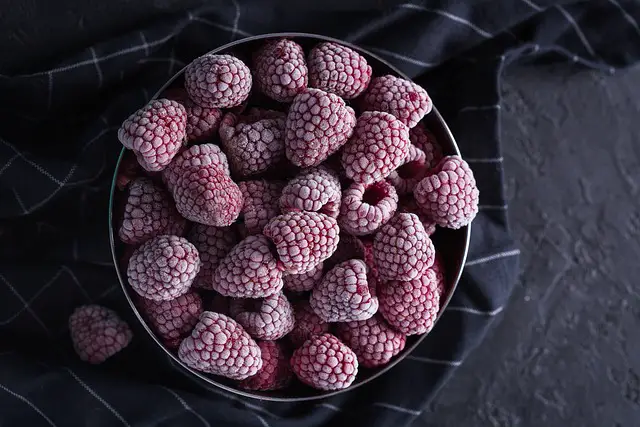
Whether you grow blackberries or raspberries at home, buy them on sale at the market, or visit a nearby pick-your-own farm, chances are at some point you’ll end up with more berries than you know what to do with. The best thing to do with a surplus of berries? Freeze them.
Related: Freezing Blackberries: The Best Ways to do It
But what do you do when it’s time to defrost them? I’m always annoyed when my previously firm frozen berries end up mushy and partially disintegrated when they thaw. How do you defrost blackberries and raspberries without ending up with a mushy mess?
To keep the best texture, thaw frozen raspberries and blackberries at room temperature, in a bag under cool water, or overnight in the refrigerator. To thaw berries quickly, use the microwave’s defrost setting.
These four methods all work well, but for different reasons. Below, I’ll break down exactly how to do each method, how long it takes, and what’s best about it. Soft, mushy blackberries and raspberries will be a thing of the past.
The Best Ways to Defrost Frozen Blackberries and Raspberries

Blackberries, raspberries, loganberries, tayberries, marionberries, and mulberries can all be defrosted the following ways. A couple of general tips to keep in mind:
- Be gentle! These berries bruise and break apart easily.
- You’ll get the most firm texture if the berries are just defrosted, but still cool.
- If a little too much liquid is released, strain the defrosted berries before adding them to recipes.
- The longer the thawed berries sit around, the softer they’ll get. Best to eat them right away.
1. Room Temperature
- What’s good about this method: Simple, relatively fast
- Texture: Pretty firm, no liquid released
- Time: 1/2 hour – 1 hour (more for a larger amount of berries)
How to do it: Place the berries you want to defrost in a bowl, then let it sit out on a counter until defrosted. If desired, gently stir the berries once or twice to thaw a little quicker.

This was perhaps the easiest method to use. I did notice that the berries had the best texture when they were fully defrosted, but still cold. The longer the fruit sat on the counter, the softer they got and the more liquid they released.
I would use this method if I wanted to have fresh berries for a parfait, oatmeal, or fruit salad. Be sure to defrost right before serving if you want them to stay firm.
2. Cool Water
- What’s good about this method: Pretty fast, best texture
- Texture: The most firm of all 4 methods, no liquid released
- Time: Less than 1/2 hour (more for a larger amount of berries)
How to do it: Place the frozen berries in an airtight bag, such as a ziplock bag. Fill the sink or a bowl with cool water, then submerge the bagged berries. You may need to weigh down the bag with something. As soon as the berries are no longer frozen, remove them from the bag.
If I had to choose only one method, this would be it. It was fast and resulted in the best texture. The berries were still quite firm with no liquid released. Like with the room temperature method, the longer you leave the berries sitting out in the water, the softer they get, so use them right away.
(Some sources suggest rinsing frozen berries directly under a slow stream of cool water. In my experience, this makes the berries break down and become much softer. It may be a fast way to defrost, but you lose a lot of texture.)
3. Overnight in Refrigerator
- What’s good about this method: Simple, ready for the following morning
- Texture: Slightly soft, a small amount of liquid released overnight
- Time: 4-8 hours (more for a larger amount of berries)
How to do it: Put the frozen berries in a bowl and place it in the refrigerator. The berries will be defrosted after about 4 to 6 hours, or overnight.
If you want thawed raspberries or blackberries ready to eat with breakfast, this is the way to do it. Defrosting the berries overnight in the fridge did make them slightly softer and release a little more liquid than the room temperature or cool water methods.

It’s possible that if you only let them defrost for 4 hours or so they might have kept more texture, but I didn’t test this. After all, the idea is to let them defrost while you are sleeping. But the texture was still pleasant and not too mushy.
4. Microwave
- What’s good about this method: Fastest, best method if in a hurry
- Texture: Soft, some liquid released
- Time: 1-2 minutes (more for a larger amount of berries)
How to do it: Place the frozen berries in a microwave-safe bowl. Using the defrost setting (or at 30% power), microwave the berries in 30-second intervals until completely defrosted. Depending on how many berries there are, this may take about 1-5 minutes.
This method works really well, especially if you are in a hurry. The key is to keep the heat very low, and keep an eye on the berries. As soon as they are no longer frozen but still cold, take them out. If you microwave too long, they will get very soft.
The texture was still somewhat firm, although the berries did release some liquid. It was a very similar result to the fridge-defrosted version, but of course much quicker.
What You Need to Know about Defrosting Berries
You don’t always need to do it.
When I’m making a recipe with my frozen blackberries or raspberries, often the easiest thing to do is just throw the frozen fruit right in. I often use frozen berries in baked goods like muffins, breads, pies, or scones – like these Blood Orange and Raspberry Sour Cream Scones.

Frozen berries can be used for any cooked application as well, like oatmeal, sauces, or preserves. (They work perfectly in my Blackberry Blood Orange Marmalade.) If you know you can use the berries while frozen, then there’s no need to thaw them out.
The texture will be different.
No matter how careful you are, thawed, previously frozen raspberries or blackberries will always be softer than fresh berries. There’s no way to keep that perfectly firm texture once they’re frozen. There are a couple of things you can do to help, though.
First, freeze the berries as quickly as possible. I wrote an article all about how to freeze blackberries (and raspberries) here: Freezing Blackberries: The Best Ways to Do It. If you freeze your berries carefully and quickly, they’ll have better texture when defrosted.

When the ice crystals melt, they will break down the texture of the berries a little bit and release some liquid. If you’re concerned about adding too much liquid to a recipe, just drain the defrosted berries in a colander for a few minutes before adding them in.
You can’t re-freeze them.
I suppose you could re-freeze berries that were previously frozen and defrosted, but the texture would be mush. If you have leftover defrosted berries, puree them in a smoothie, or make a simple blackberry or raspberry syrup for pancakes (or cocktails!) by cooking them down with some sugar.
Frozen blackberries might turn partially red.
Blackberries often turn red when they experience a sudden temperature change, such as freezing. It’s called reversion, and it won’t affect the berries’ flavor at all. When the berries are defrosted they will keep the reddened color, but they’ll taste just as sweet.
Learn more: Blackberries Turning Red? Here’s What’s Happening
Thaw berries right before you need them.
As I mentioned above, the longer thawed berries sit around, the mushier they get. Whichever defrosting method you choose, be sure to thaw berries only right before you plan to use them. If you’re anything like me, they’ll get used up before too long.

